015. Sooty Albatross (formerly known as Dark-mantled Sooty Albatross) Phoebetria fusca (Bruinalbatros)
Order: Procellariiformes. Family: Diomedeidae
Description
Size 85 cm. Wingspan 205 cm. A medium sized dark albatross with uniformly dark chocolate brown plumage and with a diamond-shaped tail. The sides of the head are slightly darker brown than the rest of the body and the legs and feet are pale grey. A white crescent surrounds the eye, and the bill is black with a yellow-orange groove in the lower jaw.
Juveniles can show a paler, greyish collar, but the back remains dark throughout.
Distribution
Southern regions of the Atlantic and Indian Oceans, East to Australia. Breeds on temperate and sub-Antarctic islands in the southern oceans, dispersing in the non-breeding season across areas from 30-60° South. In southern Africa it occurs in oceanic waters far off the south and south-western coast of South Africa, although it is a rare vagrant closer to the coast. Best chance of being seen while on a Pelagic cruise.
Habitat
Inhabits sub-Antarctic and subtropical marine waters.
Movements and migrations
It is present year-round in southern Africa, although most birds return to their colonies in early September so that the chicks can fledge in May.
Diet
The Sooty Albatross eats cephalopods, fish, crustaceans and carrion, but unlike many other albatross species, it seldom follows fishing vessels to catch food.
Breeding
Egg-laying occurs between September and December, with a single egg laid in a nest made from a mound of mud and plant matter. The egg is incubated by both parents for 65–75 days. Parental care continues after hatching, and the chick is fed and guarded for the next five months, at which time it leaves the nest and becomes independent.
Status
Rare in southern offshore waters. The sooty albatross is classified as Endangered (EN) on the IUCN Red List.
Africa Wild Bird Book
Sooty Albatross Photos
015. Sooty Albatross (formerly known as Dark-mantled Sooty Albatross) Phoebetria fusca (Bruinalbatros)
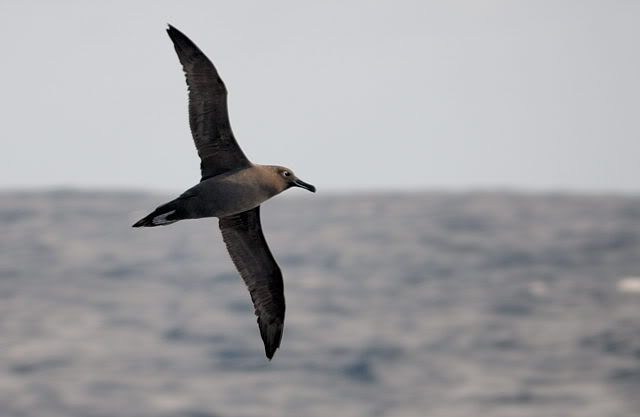
Links:
Sasol

Links:
Sasol
Light-mantled Albatross
016. Light-mantled Albatross (formerly known as Light-mantled Sooty Albatross) Phoebetria palpebrata (Swartkopalbatros)
Order: Procellariiformes. Family: Diomedeidae

Description
Size 84 cm. Wingspan 215 cm. Greyer brown than Sooty Albatross with paler back in all plumages, but juveniles and immatures generally darker backed. Has a longer winged appearance than Sooty and a different flight pattern which can be discernable at long distance once familiar with the species. Bill has a thin blue line on the sulcus (a groove along the lower mandible of the bill).
Distribution
Circumpolar in the Southern Oceans. Breeds on sub-Antarctic Islands. It disperses over cold Antarctic waters in summer as far south as the pack ice but ranges north into temperate and sub-tropical seas in winter, but generally staying below 40° South. It is a winter vagrant to southern African waters, as there are six records of stranded birds along the coast of South Africa and southern Mozambique, all within the period from May-September.
Diet
The diet is primarily composed of cephalopods and euphausiids, but birds also take fish and carrion.
Breeding
A biennial breeder usually nesting solitarily or in small colonies. Most eggs are laid in October-November, hatch in December-January and chicks fledge in May-June. Egg laying is highly synchronous within each colony. It nests on cliff ledges, on a pedestal nest of mud and peat, lined with grass.
Status
Very rare vagrant to southern offshore waters. Classified as Near Threatened (NT) on the IUCN Red List.
Order: Procellariiformes. Family: Diomedeidae

Description
Size 84 cm. Wingspan 215 cm. Greyer brown than Sooty Albatross with paler back in all plumages, but juveniles and immatures generally darker backed. Has a longer winged appearance than Sooty and a different flight pattern which can be discernable at long distance once familiar with the species. Bill has a thin blue line on the sulcus (a groove along the lower mandible of the bill).
Distribution
Circumpolar in the Southern Oceans. Breeds on sub-Antarctic Islands. It disperses over cold Antarctic waters in summer as far south as the pack ice but ranges north into temperate and sub-tropical seas in winter, but generally staying below 40° South. It is a winter vagrant to southern African waters, as there are six records of stranded birds along the coast of South Africa and southern Mozambique, all within the period from May-September.
Diet
The diet is primarily composed of cephalopods and euphausiids, but birds also take fish and carrion.
Breeding
A biennial breeder usually nesting solitarily or in small colonies. Most eggs are laid in October-November, hatch in December-January and chicks fledge in May-June. Egg laying is highly synchronous within each colony. It nests on cliff ledges, on a pedestal nest of mud and peat, lined with grass.
Status
Very rare vagrant to southern offshore waters. Classified as Near Threatened (NT) on the IUCN Red List.
Light-mantled Albatross Photos
016. Light-mantled Albatross (formerly known as Light-mantled Sooty Albatross) Phoebetria palpebrata (Swartkopalbatros)
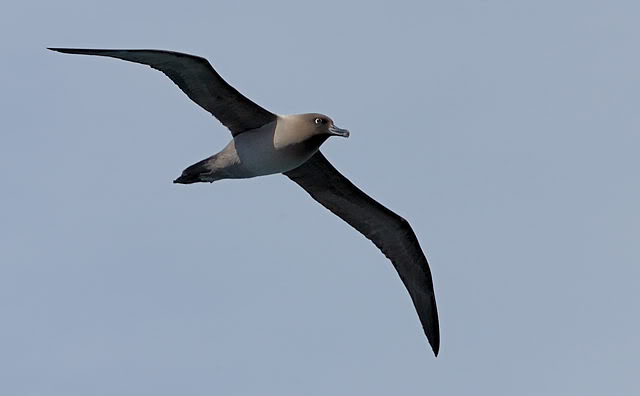

Links:
Sasol
NEWMAN'S VOELS VAN SA (8ste UIT)
More photos by Dewi: https://africawild-forum.com/viewtopic.p ... t=50#p3605


Links:
Sasol
NEWMAN'S VOELS VAN SA (8ste UIT)
More photos by Dewi: https://africawild-forum.com/viewtopic.p ... t=50#p3605
Indian Yellow-nosed Albatross
014a. Indian Yellow-nosed Albatross Thalassarche carteri (Indiese Geelneusalbatros)
Order: Procellariiformes. Family: Diomedeidae
Description
Size 76 cm. Wingspan 200 cm. A black and white bird, it has just one blaze of colour - a yellow stripe running down the top of the bill, blending into red at the tip – to which it owes its name. The back, upperwings and tail are dark grey, fading to very pale grey across the head and neck, and white on the underwings and rump. The underwings are tipped with black and have a narrow margin of black at the leading edge. The legs are pale bluish pink. The sexes are alike, but juveniles have a white head and black bill.
Very similar to Atlantic Yellow-nosed Albatross, but lacks grey cheeks and has smaller black eye patch. Note that some references mention a difference in the yellow on the bill, but this is misleading.
Distribution
Southern Indian Ocean East to Australian Southern coasts. The Indian yellow-nosed albatross breeds in the south-west Indian Ocean (on Prince Edward Island, the Crozet Islands, the Kerguelen Islands, Amsterdam Island and the St Paul Islands). Outside the breeding season, the Indian Yellow-nosed Albatross disperses throughout the Indian Ocean mainly between 25-50° South and can be found off the south-western coast of Australia, east to the Tasman Sea and off northeastern New Zealand. In Southern Africa it is common off the southern and eastern coasts of South Africa, while more scarce off the northern Cape and southern Mozambique.
Habitat
Spending the non-breeding season out at sea, the Indian yellow-nosed albatross comes to land only during the breeding season, preferring slopes and cliffs in bare, rocky regions, with little vegetation.
Movements and migrations
Present year-round off the south coast, although it is most common in the period from June-September, as most birds return to their breeding colonies in August.
Diet
Often following fishing vessels, the Indian Yellow-nosed Albatross feeds on fish, crustaceans and cephalopods. It feeds by snatching prey from the surface and by diving into the water.
Breeding
Adult Indian Yellow-nosed Albatrosses return to the breeding colonies in late August, where they form loose groups on slopes and cliffs. The female lays just one large, white egg which is incubated by both the male and the female. The chick is fed and cared for until late March to mid April, when it fledges and begins to feed itself. They breed annually.
Status
Comon winter visitor to east coast waters. The Indian Yellow-nosed Albatross is classified as Endangered on the IUCN Red List.
Order: Procellariiformes. Family: Diomedeidae
Description
Size 76 cm. Wingspan 200 cm. A black and white bird, it has just one blaze of colour - a yellow stripe running down the top of the bill, blending into red at the tip – to which it owes its name. The back, upperwings and tail are dark grey, fading to very pale grey across the head and neck, and white on the underwings and rump. The underwings are tipped with black and have a narrow margin of black at the leading edge. The legs are pale bluish pink. The sexes are alike, but juveniles have a white head and black bill.
Very similar to Atlantic Yellow-nosed Albatross, but lacks grey cheeks and has smaller black eye patch. Note that some references mention a difference in the yellow on the bill, but this is misleading.
Distribution
Southern Indian Ocean East to Australian Southern coasts. The Indian yellow-nosed albatross breeds in the south-west Indian Ocean (on Prince Edward Island, the Crozet Islands, the Kerguelen Islands, Amsterdam Island and the St Paul Islands). Outside the breeding season, the Indian Yellow-nosed Albatross disperses throughout the Indian Ocean mainly between 25-50° South and can be found off the south-western coast of Australia, east to the Tasman Sea and off northeastern New Zealand. In Southern Africa it is common off the southern and eastern coasts of South Africa, while more scarce off the northern Cape and southern Mozambique.
Habitat
Spending the non-breeding season out at sea, the Indian yellow-nosed albatross comes to land only during the breeding season, preferring slopes and cliffs in bare, rocky regions, with little vegetation.
Movements and migrations
Present year-round off the south coast, although it is most common in the period from June-September, as most birds return to their breeding colonies in August.
Diet
Often following fishing vessels, the Indian Yellow-nosed Albatross feeds on fish, crustaceans and cephalopods. It feeds by snatching prey from the surface and by diving into the water.
Breeding
Adult Indian Yellow-nosed Albatrosses return to the breeding colonies in late August, where they form loose groups on slopes and cliffs. The female lays just one large, white egg which is incubated by both the male and the female. The chick is fed and cared for until late March to mid April, when it fledges and begins to feed itself. They breed annually.
Status
Comon winter visitor to east coast waters. The Indian Yellow-nosed Albatross is classified as Endangered on the IUCN Red List.
Indian Yellow-nosed Albatross Photos
014a. Indian Yellow-nosed Albatross Thalassarche carteri (Indiese Geelneusalbatros)

Links:
Sabap2: http://sabap2.adu.org.za/spp_summary.ph ... §ion=3
Sasol
NEWMAN'S VOELS VAN SA (8ste UIT)
Trevor Hardaker Photos

Links:
Sabap2: http://sabap2.adu.org.za/spp_summary.ph ... §ion=3
Sasol
NEWMAN'S VOELS VAN SA (8ste UIT)
Trevor Hardaker Photos
Shy Albatross
011. Shy Albatross Thalassarche cauta (Bloubekalbatros)
Order: Procellariiformes. Family: Diomedeidae

Description
Size 99 cm. Wingspan 255 cm.The largest of the medium sized Albatross species. Juveniles have pale yellow/blue bills with a dark tip, and a grey hindneck. Adults have yellow bills with slightly darker tip. Underwing mostly white with narrow black leading and trailing edge. In flight has a rakish appearance.
Distribution
Circumpolar in Southern Oceans, but rare in the South Atlantic West of South Africa. It breeds on islands off New Zealand and Tasmania, dispersing across the southern Indian Ocean to southern African waters, where it is especially common off the southern and western coast of South Africa and Namibia.
Habitat
It generally prefers water on the continental shelf, while more scarce further out in the ocean.
Movements and migrations
The first fully fledged juveniles arrive off the Eastern Cape in August, moving to the Western Cape in about a month.
Diet
They usually forage singly and have been observed taking prey from the surface or occasionally making surface plunges or shallow dives. They commonly plunge-dive within 3 m of the surface and can swim down to over 7m. The main foods are fish and cephlapods and also crustaceans and tunicates. It is a ship-follower and fish processing discharge comprises a significant proportion of its diet.
Breeding
Thalassarche cauta is an endemic breeder in Australia, with colonies on three islands off Tasmania. Nests are a mound of soil, grass and roots, and are located on rock islands. Eggs are mostly laid in September and hatch in December and chicks fledge mostly in April. Immature birds return to their breeding colony at least 3 years after fledging, mostly beginning breeding when at least 5 to 6 years old, nearly always in their natal colonies.
Call
Listen to Bird Call.
Status
Common winter and uncommon summer visitor.
Order: Procellariiformes. Family: Diomedeidae

Description
Size 99 cm. Wingspan 255 cm.The largest of the medium sized Albatross species. Juveniles have pale yellow/blue bills with a dark tip, and a grey hindneck. Adults have yellow bills with slightly darker tip. Underwing mostly white with narrow black leading and trailing edge. In flight has a rakish appearance.
Distribution
Circumpolar in Southern Oceans, but rare in the South Atlantic West of South Africa. It breeds on islands off New Zealand and Tasmania, dispersing across the southern Indian Ocean to southern African waters, where it is especially common off the southern and western coast of South Africa and Namibia.
Habitat
It generally prefers water on the continental shelf, while more scarce further out in the ocean.
Movements and migrations
The first fully fledged juveniles arrive off the Eastern Cape in August, moving to the Western Cape in about a month.
Diet
They usually forage singly and have been observed taking prey from the surface or occasionally making surface plunges or shallow dives. They commonly plunge-dive within 3 m of the surface and can swim down to over 7m. The main foods are fish and cephlapods and also crustaceans and tunicates. It is a ship-follower and fish processing discharge comprises a significant proportion of its diet.
Breeding
Thalassarche cauta is an endemic breeder in Australia, with colonies on three islands off Tasmania. Nests are a mound of soil, grass and roots, and are located on rock islands. Eggs are mostly laid in September and hatch in December and chicks fledge mostly in April. Immature birds return to their breeding colony at least 3 years after fledging, mostly beginning breeding when at least 5 to 6 years old, nearly always in their natal colonies.
Call
Listen to Bird Call.
Status
Common winter and uncommon summer visitor.
Shy Albatross Photos
011. Shy Albatross Thalassarche cauta (Bloubekalbatros)

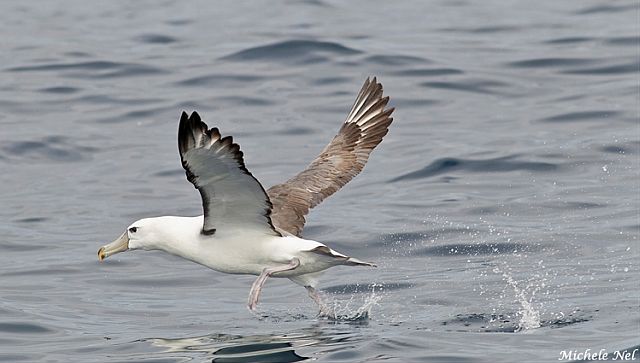 © Michele Nel
© Michele Nel
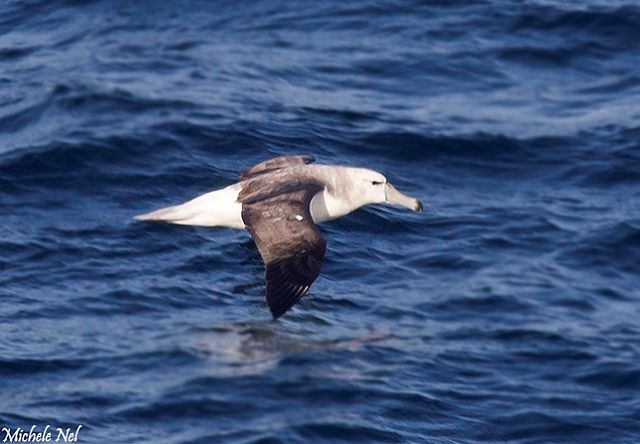 © Michele Nel
© Michele Nel
 © Michele Nel
© Michele Nel
 © Michele Nel
© Michele Nel
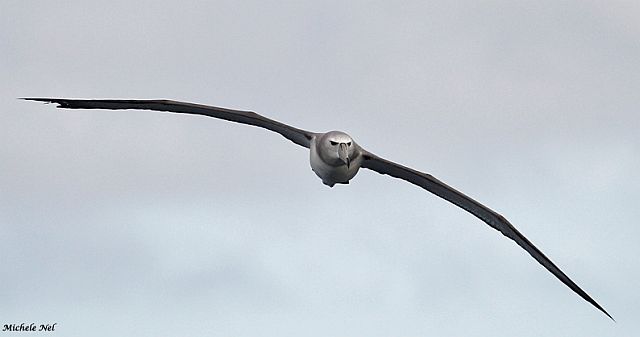 © Michele Nel
© Michele Nel
Links:
Species text Sabap1: http://sabap2.adu.org.za/docs/sabap1/011.pdf
Sasol
NEWMAN'S VOELS VAN SA (8ste UIT)
Trevor Hardaker Photos

 © Michele Nel
© Michele Nel © Michele Nel
© Michele Nel © Michele Nel
© Michele Nel © Michele Nel
© Michele Nel © Michele Nel
© Michele NelLinks:
Species text Sabap1: http://sabap2.adu.org.za/docs/sabap1/011.pdf
Sasol
NEWMAN'S VOELS VAN SA (8ste UIT)
Trevor Hardaker Photos
Atlantic Yellow-nosed Albatross
014. Atlantic Yellow-nosed Albatross Thalassarche chlororhynchos (Atlantiese Geelneusalbatros)
Order: Procellariiformes. Family: Diomedeidae
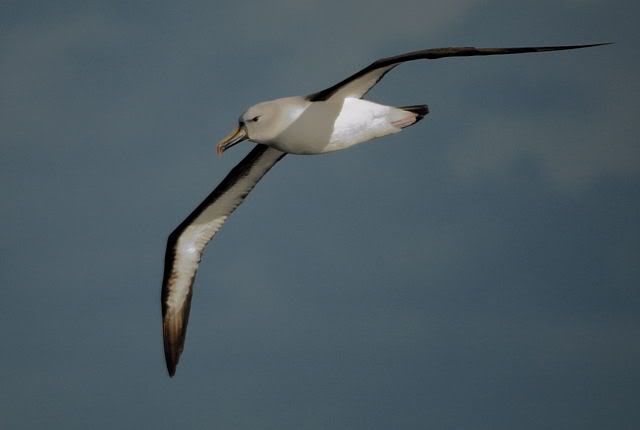
Description
Size 76 cm. Wingspan 200cm. A relatively small albatross, named after the yellow streak ending in a pink tip along the top of the bill. The head has a grey wash, and the upperparts are blackish-grey. There is a white ring around the neck and this white colouration extends across the underside. The underwings are white with narrow black band to rear and leading edges. The sexes are alike.
Juveniles have an entirely white head and black bill.
Black eye-patch larger than Indian Yellow-nosed Albatross.
Distribution
The Atlantic Yellow-nosed Albatross breeds on Gough Island and the islands of the Tristan da Cuhna archipelago in the Southern Ocean. In the non-breeding season it is found throughout the South Atlantic Ocean and has been recorded off the coast of Argentina, Brazil and the west coast of southern Africa, sometimes as far as Australia. In South Africa mainly in May-September, fairly common in the cold water off the west coast of South Africa and Namibia, while more scarce south of the Western and Eastern Cape.
Habitat
It is found out in the open ocean during the non-breeding season, in warmer waters than most albatross species.
Movements and migrations
Adults arrive at their breeding colonies in late August, with the chicks fledging from mid March-April and rapidly dispersing soon afterwards. It is present year-round in southern African waters, with a peak numbers in winter, especially from May-June off Namibia. Adults may reach southern Africa when they are incubating the eggs and raising chicks, as then they go on extremely lengthy foraging trips
Breeding
Monogamous. Breeds in southern summer with egg-laying starting in mid-September. Adults arrive at their breeding colonies between late August and early September, where the female lays a single egg in a nest built on a pedestal of mud. Single egg, white marked with brown at larger end (96 x 62mm). Incubated by both parents for about 55-60 days and young fed by both parents. Fledges after 5 months in April and May.
Diet
The Atlantic yellow-nosed Albatross often scavenges at fishing vessels and overcomes its size disadvantage by manoeuvring close enough to the boat to retrieve scraps thrown overboard. It will also steal prey from white-chinned petrels and makes use of the hunting tactics of tuna and cetaceans by plunge-diving for the fish they drive to the surface. Its diet consists of fish, crustaceans, squid and fishery by-catch.
Status
Regular visitor to west coast waters. The Atlantic yellow-nosed Albatross is classified as Endangered (EN) on the IUCN Red List.
Order: Procellariiformes. Family: Diomedeidae

Description
Size 76 cm. Wingspan 200cm. A relatively small albatross, named after the yellow streak ending in a pink tip along the top of the bill. The head has a grey wash, and the upperparts are blackish-grey. There is a white ring around the neck and this white colouration extends across the underside. The underwings are white with narrow black band to rear and leading edges. The sexes are alike.
Juveniles have an entirely white head and black bill.
Black eye-patch larger than Indian Yellow-nosed Albatross.
Distribution
The Atlantic Yellow-nosed Albatross breeds on Gough Island and the islands of the Tristan da Cuhna archipelago in the Southern Ocean. In the non-breeding season it is found throughout the South Atlantic Ocean and has been recorded off the coast of Argentina, Brazil and the west coast of southern Africa, sometimes as far as Australia. In South Africa mainly in May-September, fairly common in the cold water off the west coast of South Africa and Namibia, while more scarce south of the Western and Eastern Cape.
Habitat
It is found out in the open ocean during the non-breeding season, in warmer waters than most albatross species.
Movements and migrations
Adults arrive at their breeding colonies in late August, with the chicks fledging from mid March-April and rapidly dispersing soon afterwards. It is present year-round in southern African waters, with a peak numbers in winter, especially from May-June off Namibia. Adults may reach southern Africa when they are incubating the eggs and raising chicks, as then they go on extremely lengthy foraging trips
Breeding
Monogamous. Breeds in southern summer with egg-laying starting in mid-September. Adults arrive at their breeding colonies between late August and early September, where the female lays a single egg in a nest built on a pedestal of mud. Single egg, white marked with brown at larger end (96 x 62mm). Incubated by both parents for about 55-60 days and young fed by both parents. Fledges after 5 months in April and May.
Diet
The Atlantic yellow-nosed Albatross often scavenges at fishing vessels and overcomes its size disadvantage by manoeuvring close enough to the boat to retrieve scraps thrown overboard. It will also steal prey from white-chinned petrels and makes use of the hunting tactics of tuna and cetaceans by plunge-diving for the fish they drive to the surface. Its diet consists of fish, crustaceans, squid and fishery by-catch.
Status
Regular visitor to west coast waters. The Atlantic yellow-nosed Albatross is classified as Endangered (EN) on the IUCN Red List.
Atlantic Yellow-nosed Albatross Photos
014. Atlantic Yellow-nosed Albatross Thalassarche chlororhynchos (Atlantiese Geelneusalbatros)
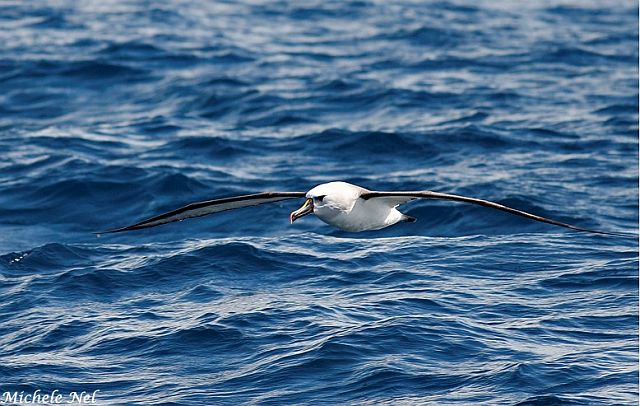 © Michele Nel
© Michele Nel
Links:
Sabap2: http://sabap2.adu.org.za/spp_summary.ph ... §ion=3
Ryan, P. 2008. It’s not love, actually. Africa - Birds & Birding 13(4):42-49.
Sasol
NEWMAN'S VOELS VAN SA (8ste UIT)
 © Michele Nel
© Michele NelLinks:
Sabap2: http://sabap2.adu.org.za/spp_summary.ph ... §ion=3
Ryan, P. 2008. It’s not love, actually. Africa - Birds & Birding 13(4):42-49.
Sasol
NEWMAN'S VOELS VAN SA (8ste UIT)


